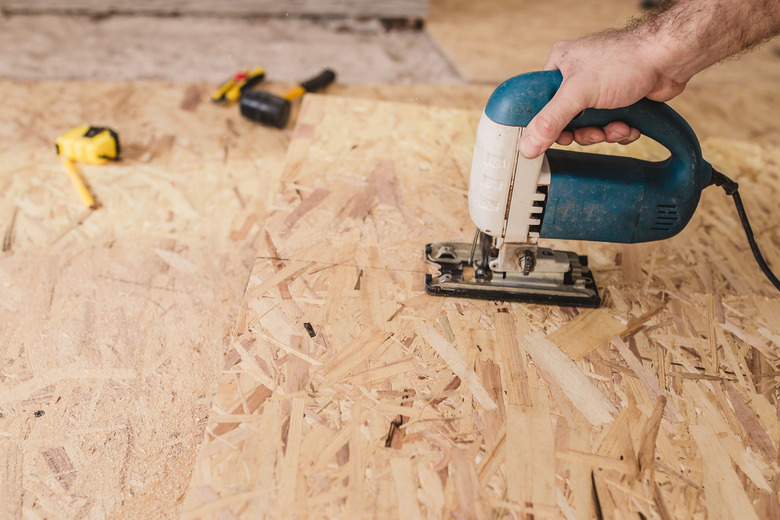OSB Floor Weight Limit
Oriented strandboard (OSB), a wood product manufactured in a cross-oriented pattern, is often used in similar applications as is plywood for various building projects. Much like plywood, this material can be used for subfloors or single-layer floors, and the OSB vs. plywood cost is comparable. OSB weight limits are assigned by the Engineered Wood Association (APA), a nonprofit trade group that defines standards for a wide range of manufactured wood products based on its accreditation by the American National Standards Institute.
About OSB Span Ratings
About OSB Span Ratings
There are two primary types of OSB used in flooring applications: OSB sheathing panels, which are designed for subflooring (as well as wall sheathing and roof sheathing), and Sturd-I-Floor, which is designed to be used as single-layer flooring under a carpet and frequently comes as tongue-and-groove. The APA panel's trademark ratings define recommended OSB spans based on each type's use.
Span ratings for sheathing are rendered as two numbers separated by a slash — for example, 32/16 or 24/0. The first number defines the maximum center-to-center spacing for supports when the OSB is used as a roof sheathing, assuming that the "strength axis" (long dimension) of the panel spans three or more supports. The second number denotes the maximum spacing for supports when the OSB is used as a subflooring, again with the long dimension spanning three or more supports.
Span ratings for Sturd-I-Floor panels use a single digit as a rating: 16, 20, 24, 32, and 48 oc, where "oc" means "on center."
OSB Floor Weight Limits
OSB Floor Weight Limits
The following are the APA span ratings for common OSB sizes. Each rating identifies a psf (pound per square foot) weight limit based on the minimum allowable support span on center. If you were to increase the number of supports, the allowable load would be higher.
OSB Sheathing:
-
3/8 inch, 24/0, 30 psf live load max
-
7/16
inch,
24/16, 40 psf live load max
-
15/32
inch,
32/16, 70 psf live load max
-
1/2
inch,
32/16, 70
psf live load max
-
19/32
inch,
40/20, 130
psf live load max
-
23/32
inch,
48/24, 175
psf live load max
-
1 1/8
inch,
48 oc, 290
psf live load max
OSB Sturd-I-Floor:
-
19/32 or 5/8 inch, 16 oc, 100 psf live load max
-
23/32 or 3/4 inch, 24 oc, 100 psf live load max
-
7/8 inch, 32 oc, 100 psf live load max
-
1 3/32 or 1 1/8 inch, 48 oc, 65 psf live load max
OSB Versus Plywood
OSB Versus Plywood
OSB is much like plywood except that instead of being composed of thin strips or sections that are layered at 90-degree angles, OSB uses interlocking strands of wood that are between 3 and 4 inches in length and interlock at the same 90-degree angle. Like plywood, OSB is usually sold in sections that are 4 x 8 feet, although OSB sizes may vary.
OSB weight is usually a bit more than its plywood counterpart. For example, 1/4-inch plywood weighs 0.8 pounds per square foot, while OSB weighs 0.9 pounds for the same thickness. Translated, a 1/4-inch 4 x 8-foot plywood panel weighs 26 pounds, while the equivalent-size OSB panel is 29 pounds. As a basis of comparison, particleboard is 35 pounds for the same size.
OSB Versus Particleboard
OSB Versus Particleboard
While OSB uses wood components and waterproof adhesives, particleboard is instead made of wood fragments, like wood chips and pulp, and then mixed together with a synthetic resin or a binder. Particleboard is mechanically pressed into a sheet and is a type of fiberboard. Particleboard is not recommended for use as a subfloor because it lacks structural strength, especially if you plan to install hardwood floor on top of it.
References
- Tolko: Oriented Strand Board
- Roof Online: Weight of Plywood, OSB, and Other Engineered Wood Panels
- APA – The Engineered Wood Association: APA Panel Trademark
- BuildDirect: Particle Board vs Oriented Strand Board: How Are They Different?
- LP Building Products: Specifications – APA Rated Sheathing & Structural 1 Sheathing
